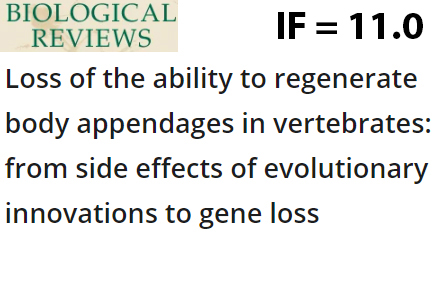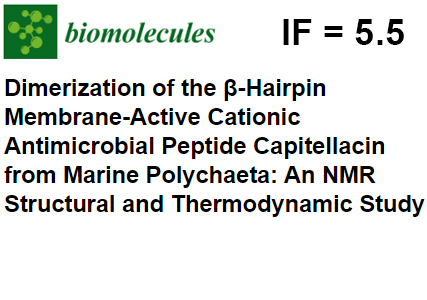Press-room / Digest

Loss of Ability to regenerate Limbs in Higher Vertebrates: From Side Effects of Evolutionary Innovations to Gene Loss
Researchers from the Laboratory of Molecular Foundations of Embryogenesis at the GNC IBCh RAS have identified the main factors that rendered limb regeneration impossible in modern amniotes (reptiles, birds, and mammals). The authors suggested that after the ancestors of amniotes transitioned to land, their ability to regenerate limbs was suppressed by the side effects of various innovations that emerged at that time, which were necessary for successful colonization of land. This, in turn, stimulated the disappearance of many genes that ceased to participate in regeneration from that moment on. As a result, in modern amniotes, including humans, the inability to regenerate limbs became firmly fixed at the genomic level. The work was supported by the Russian Science Foundation grant 23-74-30005 and published in the journal Biological Reviews. Learn more

Innovative Contact Lenses with Metal-Organic Frameworks for Glaucoma Treatment
Researchers from the Institute of Bioorganic Chemistry of the Russian Academy of Sciences, Harvard University, Sechenov University, the Pasteur Institute, and other scientific institutions in Russia and abroad have proposed a new method for controlling elevated intraocular pressure, which is a major damaging factor in glaucoma. They have developed a new type of contact lenses that incorporate metal-organic frameworks (MOFs) for the controlled and prolonged release of brimonidine, a medication used to reduce intraocular pressure. This innovation was presented in the high-ranking scientific journal Aggregate, highlighting its innovative nature and potential impact on ophthalmological practice. Learn more

NMR spectroscopy reveals patterns and thermodynamic parameters of dimerization of β-hairpin antimicrobial peptides in the membrane
Oligomerization in bacterial membrane is a key step in many proposed mechanisms of antibiotic action of antimicrobial peptides (AMPs). Thermodynamics of the dimerization process of β-hairpin AMPs in a membrane-like environment of DPC micelles was studied using the example of the capitellacin peptide from of the marine polychaete Capitella teleta. Transitions between the monomer and dimer states with changes in temperature and detergent concentration were described by NMR spectroscopy. Both structural forms of capitellacin bind to the micelle surface, which is consistent with the “carpet” mechanism of membrane action. A comparative analysis of the physicochemical properties of β-hairpin AMPs revealed a positive correlation between the hydrophobicity of the peptide, the stability of its dimers and hemolytic activity. The results of the work were published in the journal Biomolecules. Learn more

Diversifying i-motif-based pH sensors: Labeling patterns tune the intracellular localization
Scientists from IBCH together with the colleagues from Federal Research Center for Physical and Chemical Medicine developed an i-motif-based pH sensor. The authors synthesized a new non- fluorescent cytosine analogue, tC O Azo , which quenches the fluorescence of the known fluorescent cytosine mimic, tC O . Incorporation of the pair into a genomic iM-forming sequence C5T resulted in a high-contrast pH sensor with a working range compatible with physiological conditions. Unlike known C5T-based sensors, which contain conventional FAM/BHQ or FAM/TAMRA labels, provide a fluorescent signal in the green/red channels and accumulate in cell nuclei, the proposed sensor localized mainly in the cytoplasm and allowed pH monitoring based on the tC O signal in the blue channel. Thus, the authors managed to overcome the common problem of preferential accumulation in the nuclei of living cells for labeled nucleic acids (antisense oligonucleotides, molecular beacons, etc.). The work was published in Sensors and Actuators: B. Chemical.

Autologous T-Cell-Free Antigen Presentation System Unveils hCMV-Specific NK Cell Response
The scientists from the IBCh RAS proposed the autologous system of the hCMV-derived VMAPRTLFL (LFL) peptide stimulation without T lymphocytes and exogenous cytokines which allows to evaluate NK cell hCMV-specific responses. NK cells of individuals having high anti-hCMV-IgG levels, in contrast to NK cells of hCMV-seronegative and low-positive donors, displayed increased IFNγ production, degranulation and activation levels, and enhanced proliferation upon stimulation with the LFL peptide, presented in HLA-E. LFL-induced NK cell IFNγ production was dependent on PI3K and Ras/Raf/Mek signaling pathways. Transcriptomic profile of LFL-expanded NK cells showed increased adaptive gene expression and metabolic activation. This model may be further exploited for the identification of antigen-specific NK cells. The results are published in the Cells.

